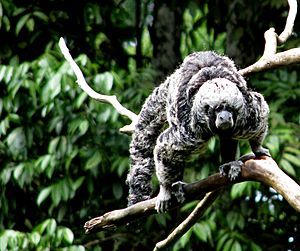Rio Tapajós saki facts for kids
Quick facts for kids Rio Tapajós saki |
|
|---|---|
 |
|
| Conservation status | |
| Scientific classification | |
| Genus: |
Pithecia
|
| Species: |
irrorata
|
 |
|
| Rio Tapajós saki range | |
The Rio Tapajós saki (pronounced Tah-pah-JOHS SAH-kee) is a unique type of saki monkey. It is also sometimes called Gray's bald-faced saki. These interesting monkeys are a kind of New World monkey, which means they live in the Americas.
You can find the Rio Tapajós saki in certain parts of South America. They live in western Brazil, southeastern Colombia, southeastern Peru, and possibly in northern Bolivia.
Contents
About the Rio Tapajós Saki
The Rio Tapajós saki is a primate, which is the group of animals that includes monkeys, apes, and humans. They are known for their distinctive appearance. Saki monkeys are usually covered in thick, shaggy fur.
Where Do They Live?
These monkeys live in the forests of South America. Their home includes parts of the Amazon rainforest. This area has many trees and plants, which is perfect for monkeys. They spend most of their lives in the trees.
The map in the infobox shows their general living area. It stretches across several countries. This wide range helps them find food and safe places to live.
What Do They Look Like?
The Rio Tapajós saki has a special look. They are often called "bald-faced" because of the fur pattern on their faces. Their fur can be different shades, often dark. Like other saki monkeys, they have long, bushy tails. These tails are often longer than their bodies. They use their tails for balance when moving through trees.
When Were They Discovered?
This species was first described by a scientist named John Edward Gray in 1842. This means he was the first to officially record and name the species. Scientists continue to study these monkeys today. They learn more about their lives and their role in the forest.
Conservation Status
The Rio Tapajós saki is currently listed as "Data Deficient" (DD) by the IUCN. This means there isn't enough information about them. Scientists need more research to know how many there are. They also need to understand if the species is at risk. Learning more about them helps protect their future.
See also
 In Spanish: Saki gris para niños
In Spanish: Saki gris para niños


